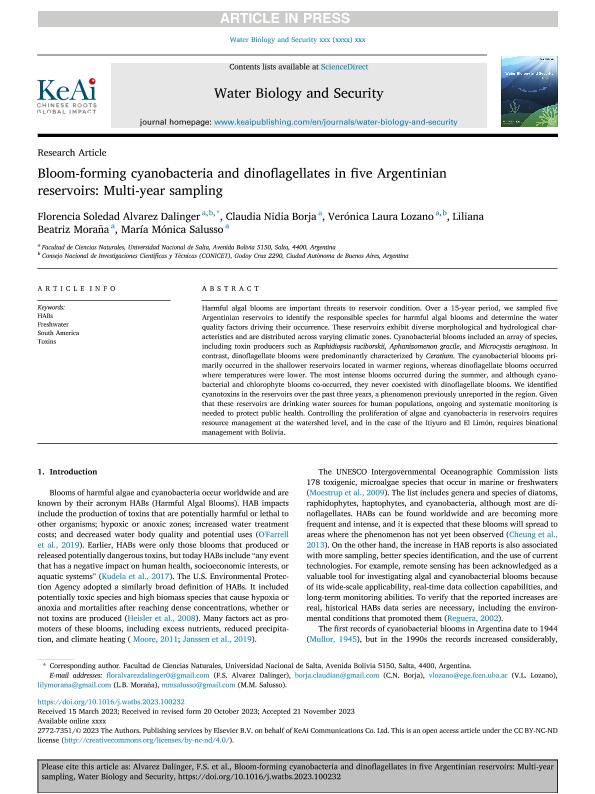Mostrar el registro sencillo del ítem
dc.contributor.author
Alvarez Dalinger, Florencia Soledad

dc.contributor.author
Borja, Claudia Nidia

dc.contributor.author
Lozano, Verónica Laura

dc.contributor.author
Moraña, Liliana Beatriz

dc.contributor.author
Salusso, Maria Monica

dc.date.available
2024-01-05T13:15:00Z
dc.date.issued
2023-11
dc.identifier.citation
Alvarez Dalinger, Florencia Soledad; Borja, Claudia Nidia; Lozano, Verónica Laura; Moraña, Liliana Beatriz; Salusso, Maria Monica; Bloom-forming cyanobacteria and dinoflagellates in five Argentinian reservoirs: Multi-year sampling; Elsevier; Water Biology and Security; 11-2023; 1-9
dc.identifier.issn
2772-7351
dc.identifier.uri
http://hdl.handle.net/11336/222546
dc.description.abstract
Harmful algal blooms are important threats to reservoir condition. Over a 15-year period, we sampled fiveArgentinian reservoirs to identify the responsible species for harmful algal blooms and determine the waterquality factors driving their occurrence. These reservoirs exhibit diverse morphological and hydrological characteristics and are distributed across varying climatic zones. Cyanobacterial blooms included an array of species,including toxin producers such as Raphidiopsis raciborskii, Aphanizomenon gracile, and Microcystis aeruginosa. Incontrast, dinoflagellate blooms were predominantly characterized by Ceratium. The cyanobacterial blooms primarily occurred in the shallower reservoirs located in warmer regions, whereas dinoflagellate blooms occurredwhere temperatures were lower. The most intense blooms occurred during the summer, and although cyanobacterial and chlorophyte blooms co-occurred, they never coexisted with dinoflagellate blooms. We identifiedcyanotoxins in the reservoirs over the past three years, a phenomenon previously unreported in the region. Giventhat these reservoirs are drinking water sources for human populations, ongoing and systematic monitoring isneeded to protect public health. Controlling the proliferation of algae and cyanobacteria in reservoirs requiresresource management at the watershed level, and in the case of the Itiyuro and El Limon, requires binational management with Bolivia.
dc.format
application/pdf
dc.language.iso
eng
dc.publisher
Elsevier

dc.rights
info:eu-repo/semantics/openAccess
dc.rights.uri
https://creativecommons.org/licenses/by-nc-nd/2.5/ar/
dc.subject
HABS
dc.subject
FRESHWATER
dc.subject
SOUTH AMERICA
dc.subject
TOXINS
dc.subject.classification
Otras Ciencias Biológicas

dc.subject.classification
Ciencias Biológicas

dc.subject.classification
CIENCIAS NATURALES Y EXACTAS

dc.title
Bloom-forming cyanobacteria and dinoflagellates in five Argentinian reservoirs: Multi-year sampling
dc.type
info:eu-repo/semantics/article
dc.type
info:ar-repo/semantics/artículo
dc.type
info:eu-repo/semantics/publishedVersion
dc.date.updated
2024-01-05T11:41:22Z
dc.journal.pagination
1-9
dc.journal.pais
China

dc.description.fil
Fil: Alvarez Dalinger, Florencia Soledad. Consejo Nacional de Investigaciones Científicas y Técnicas; Argentina. Universidad Nacional de Salta; Argentina
dc.description.fil
Fil: Borja, Claudia Nidia. Universidad Nacional de Salta. Facultad de Cs.naturales. Catedra Biologia y Diversidad de Protistas Autotrofos y Fungi.; Argentina
dc.description.fil
Fil: Lozano, Verónica Laura. Consejo Nacional de Investigaciones Científicas y Técnicas; Argentina. Universidad Nacional de Salta; Argentina
dc.description.fil
Fil: Moraña, Liliana Beatriz. Universidad Nacional de Salta. Facultad de Cs.naturales. Catedra Biologia y Diversidad de Protistas Autotrofos y Fungi.; Argentina
dc.description.fil
Fil: Salusso, Maria Monica. Universidad Nacional de Salta. Facultad de Cs.naturales. Catedra Biologia y Diversidad de Protistas Autotrofos y Fungi.; Argentina
dc.journal.title
Water Biology and Security
dc.relation.alternativeid
info:eu-repo/semantics/altIdentifier/url/https://linkinghub.elsevier.com/retrieve/pii/S2772735123001270
dc.relation.alternativeid
info:eu-repo/semantics/altIdentifier/doi/http://dx.doi.org/10.1016/j.watbs.2023.100232
Archivos asociados
